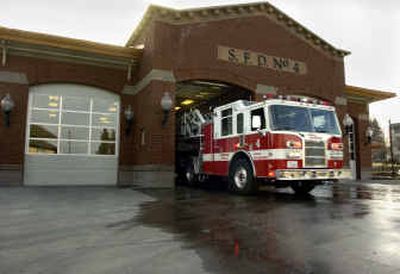New fire station opens amid personnel cuts

One month after the city of Spokane cut 52 firefighters, crews at Fire Station No. 4 are moving into spacious new quarters at the Maple Street loop downtown.
The contradiction between layoffs and new buildings is just the latest example of the split nature of city policy-making, largely the result of differences in how city services are funded.
Bonds approved by voters last November will fix city streets over the next decade, but the police department won’t be buying any new police cars in 2005 to patrol those streets. Police are putting off car purchases to save money for department salaries. Even so, 20 uniformed positions were cut this year as a result of a city budget crisis.
Crisis or not, work will begin this year on 110 miles of streets to be financed over 20 years through $117 million in bond sales. Repayment on the borrowing will take 20 years.
The opening of the $2.5 million Station No. 4 at the west end of downtown this week is being greeted with enthusiasm. It is one of two new stations expected to go on line in the city this year. A replacement for Station No. 18 is under construction at Lincoln Road and Colton Street on the North Side. The city also opened a new combined police-fire communications center at Spokane Community College last year.
All of the work, plus new equipment, is being funded through a $21.4 million fire bond issue. The measure won voter approval in 1999, when city finances were in better shape and the economy was relatively healthy.
“At that time, we didn’t know we had a budget problem,” explained Fire Chief Bobby Williams.
In the past several years, nonvoted tax collections have not kept pace with rising costs for salaries, health care and jail. Unlike the federal government, the city cannot go into debt for year-to-year operations.
But the mayor and City Council can ask voters to approve property tax increases to pay for buildings, equipment and other physical assets. The parks department is considering a ballot measure for pools and other park needs later this year.
The distinction between voter-approved bonds and nonvoted revenue has not escaped fire union leaders.
They want city elected leaders to put a special levy on the ballot to increase funding for public safety operations. State law limits such operating levies to one year.
“We’ve always had good support from the citizens,” said Lt. Greg Borg, president of the firefighters’ Local 29.
“Balancing the budget to cut 52 people is not in alignment with support the citizens have shown us in the past,” Borg said.
Firefighters from Spokane and other communities in Washington recently lobbied lawmakers to allow public safety levies of up to six years.
At Station No. 4, firefighters have twice the space, and a safer working environment, than they had at the old station No. 4 at First and Adams.
But they are paying the price in terms of staffing. The department eliminated one of the station’s crew members for 2005, leaving a greater workload for the seven remaining firefighters, who staff a ladder, an engine and a technical rescue rig.
Even so, firefighters are pleased with the new facility.
“We do appreciate the taxpayers doing this for us,” said firefighter Jerry Shaw, who drives the ladder truck at the station.
With 12,000 square feet of space, the new Station No. 4 is large enough that the old station could fit inside its four roomy truck bays.
“It’s so big it’s easy to get lost in it,” Shaw said.
The old station barely had room to contain the ladder truck. Work space around the rig was below the three-foot space standard in state labor regulations. The new station has room for the station’s three trucks, plus plenty of work space, and an extra bay in case the city grows enough to warrant a fourth truck at the station.
New features include exhaust systems to keep diesel fumes out of the building; a separate gear room to keep smoky turnouts from contaminating the work environment; roomier sleeping quarters; separate offices for truck commanders; a larger exercise room; and a community meeting room.
The new station’s turn-of-the-century design reflects the look of the original Station No. 4, which was built at First and Adams the year after the Great Fire of 1889, an event that caused the city to organize an all-paid force. The original building was replaced in 1964 with the second Station No. 4 at the same location.
“We tried to honor the finer architecture of Browne’s Addition,” said architect Denny Christenson, who designed the building after holding regular meetings with a committee of firefighters and representatives from adjoining neighborhoods.
In 1989 and again in 1999, the department won voter support for new stations, a combined police-fire dispatch center, training center and new trucks. Money for those improvements has been paid through excess property tax collections added to city tax bills each year.
While voters have supported fire operations, they also have sent their own mixed signals to public officials.
The crisis in the operating budget at City Hall can be traced back to 1999 when voters repealed the state’s motor vehicle excise tax, which had been a source of money for general city services, including fire and police. A weak economy in recent years contributed to sluggish growth in non-voted tax collections.
“I think everybody is supportive of it,” Gary Pollard, chair of the Riverside Neighborhood Council, said of the new fire station. “If they were able to keep it under budget and have a nice-looking facility, I think that’s great.”